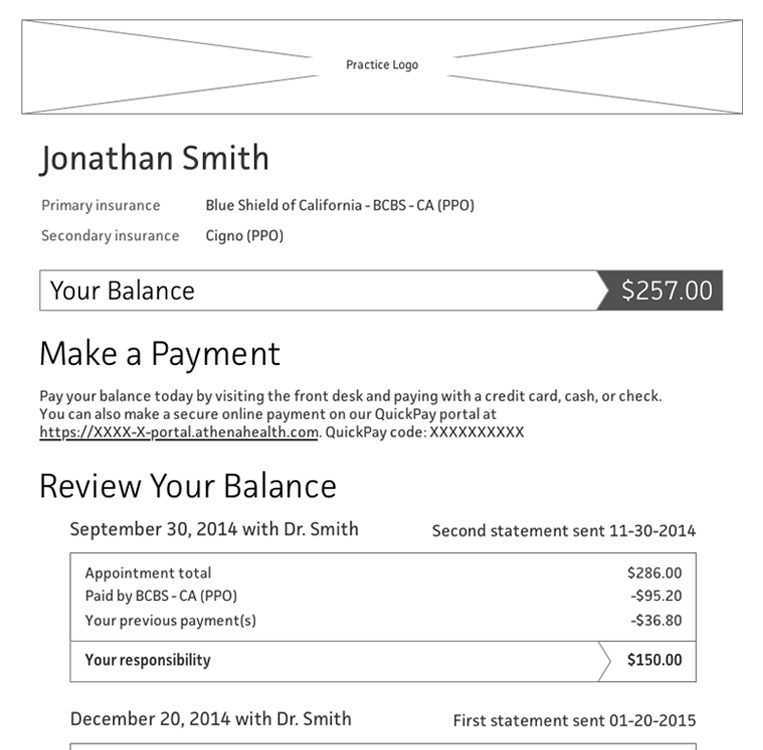Timeline
3 weeks
June 1 – 22, 2015
Context
Collecting payments from patients is always a difficult process. Sometimes patients pay their medical bills quickly, but sometimes they take a while to settle their balances. Medical practices will send up to four notices that payment is due before passing the bill along to a collections agency. Unfortunately, medical bills can be very confusing and hard to understand, which may lead to patients not wanting to pay; if they don't fully understand what they're paying for, they are unlikely to make a payment.
Medical practices need a better way to communicate information regarding outstanding balances to their patients. We decided to make a coversheet to be given to patients at the time of payment to clearly present their outstanding balance to them.
Problem
I can't figure out what the details of my medical bill mean.
Medical bills are oftentimes confusing and are designed in way that makes it hard for patients to understand what they are reading. To address these complications, we decided to simplify the presentation of information by removing unnecessary information, grouping related items, and using intentional language to clearly communicate everything on the medical bill.
I don't know what I'm paying for, so I'm not going to pay.
Complex medical language and jargon is found all over medical bills. We decided to eliminate all medical terminology and only reference the total cost of an appointment, the total amount that insurance has covered, and how much is left for the patient to pay. We also decided to show the doctor's name, appointment date, and when their last statement was sent to them to add context to the outstanding balance.
I'm uncomfortable asking questions about my bill.
Discussing outstanding balances in a doctor's office with other people around can be uncomfortable for patients. We decided to include an FAQ section to address questions that most patients have to allow them to get answers to some of their questions without having to sacrifice their privacy. We also were very intentional with the layout of the coversheet so that the order in which the content would be read would mimic the order in which a conversation would be had.
Process
Identify Coversheet Goals
The first step of the process was identifying what we wanted to accomplish with the coversheet. We interviewed people who work at front desks of doctor's offices and patients to understand how the current process works and where improvements could be made. We also examined medical bills to find their problem areas.
Once we understood what aspects of medical bills were confusing patients, we were able to identify what information patients needed to feel comfortable making their payment. These pieces of information included:
- Patient's name
- Patient's insurance
- The outstanding balance
- How to make a payment
- For each appointment:
- Date
- Doctor
- Most recent statement
- Appointment total
- Amount paid by insurance
- Amount previously paid by patient
- Balance for that appointment
Initial Wireframes and Designs
Knowing what information needed to be included on the coversheets, I wireframed its general flow of information, deciding what information should go where. Once the wireframe was completed and approved, I started making low-fidelity mockups and moved on to high-fidelity mockups as the process continued and more details were necessary. This process was partly iterative, and by the time I was finished, I had created over 100 different designs.
This is one of the iterations during the process:

Here's what the heads up was about
I created approximately two dozen designs but unfortunately I can't show them all here.
Beta Test
I presented my designs to my team and after a thorough discussion, we settled on one of the designs with which we would move forward. At the same time, our client-facing team members solidified a client who was willing to run a beta test with the coversheets. This accelerated the process quite a bit, pushing me to refine the design quickly and pass it along to our team's copy writer. Once it was ready, we launched the beta program.
The beta test lasted a week during which approximately 30 patients received coversheets. The feedback that we received was very positive; patients enjoyed the new coversheets, saying that it made it much easier for them to understand their medical bills. Overall, the coversheet was a success, having addressed a pressing need felt by both patients and doctor's offices.
Next Steps
I left the project before the beta test ended, so I'm unaware of the exact status of the coversheet project. I imagine that my team continued to iterate on it and is released it to clients.
Biggest Takeaways
- To convince people that a specific design is best, you have to show them alternatives
- Designing for print is drastically different from designing for web; web designs shouldn't be printed without alterations
- Copy is a crucial part of the design process that shouldn't be overlooked